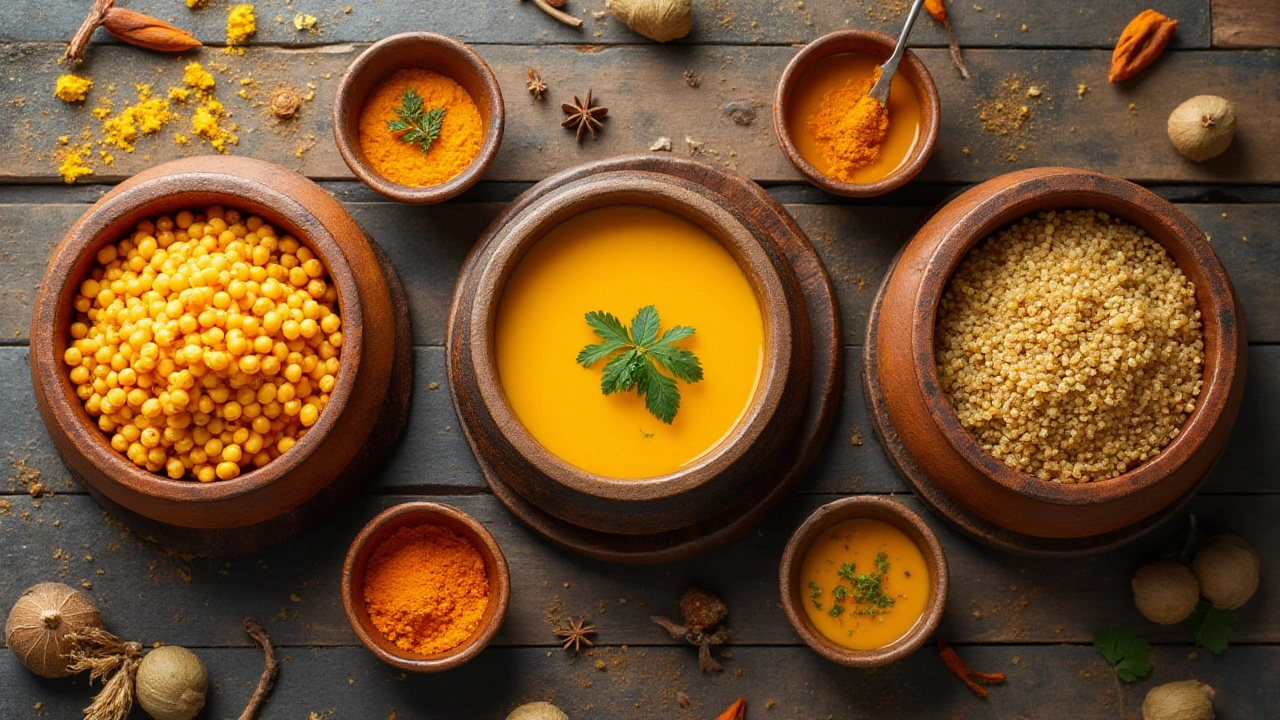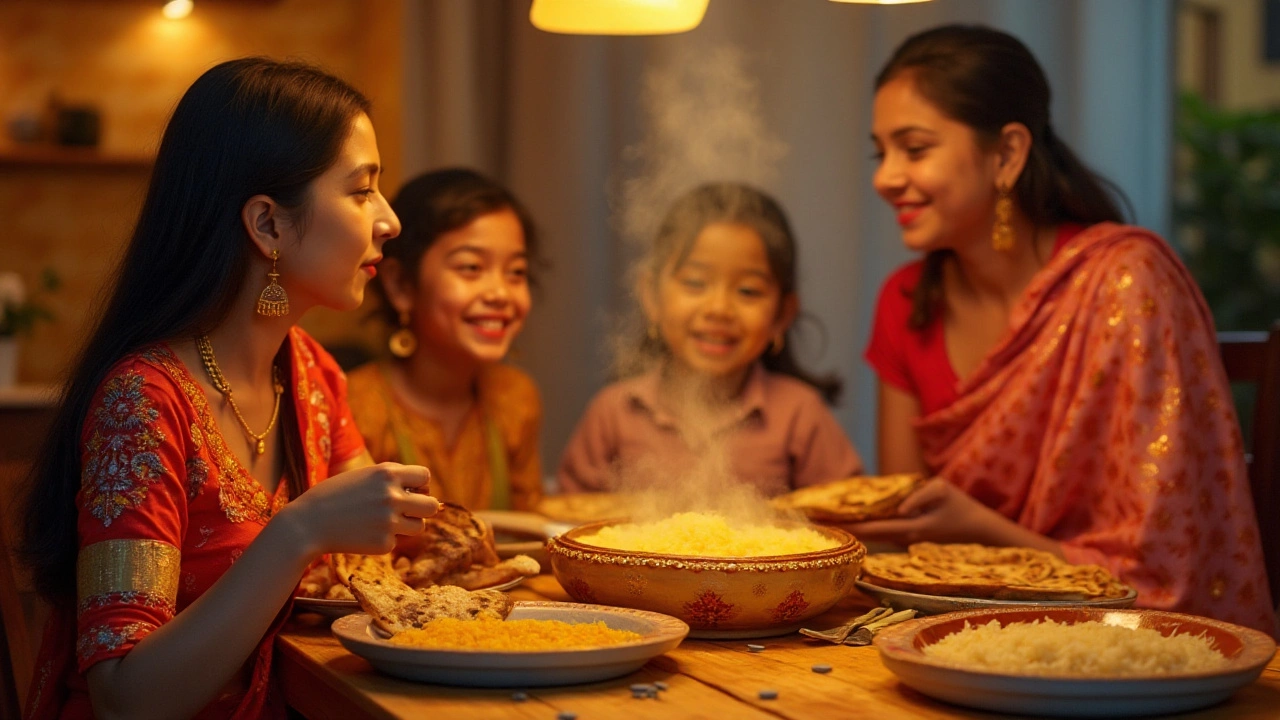28 Jan 2025
- 0 Comments
When it comes to a fulfilling and healthy dinner, dal often takes a spot in the top list of meals that are both satisfying and nutrient-rich. This staple of Indian cuisine is more than just a side dish; it is a powerhouse of nutrition that can be beneficial at any time of the day, especially at night.
Dal, made from various types of lentils, serves as a fantastic source of proteins, minerals, and vitamins crucial for your daily nutritional needs. The slow-digesting carbohydrates in dal fuel your body steadily, avoiding spikes in blood sugar levels, which can be particularly useful before bedtime.
- The Nutritional Power of Dal
- Digestive Benefits at Night
- Dal Varieties and Their Flavors
- Quick and Simple Dal Recipes
- Incorporating Dal into Your Night Meal Plan
- Tips for Enhancing Your Dal Experience
The Nutritional Power of Dal
Dal, often known as the humble lentil, is a nutritional gem hidden in plain view, offering an impressive profile that caters to multiple bodily needs. In many cultures, especially within Indian cuisine, dal is not just another meal but an integral part of the daily diet that provides a substantial amount of plant-based proteins. Proteins are critical as they are the building blocks of our body, supporting everything from muscle repair to hormone production.
Aside from its protein content, dal is a repository of essential vitamins and minerals. Vitamins such as B-complex, including folate and niacin, are present in abundance, supporting cellular function and energy metabolism. Minerals like magnesium, iron, and potassium help in maintaining cardiovascular health, regulating blood pressure, and ensuring oxygen is efficiently transported throughout the body. Often, the body's ability to remain energized and alert is credited to these nutrients, which form a large part of dal's composition.
According to nutritionist Rujuta Diwekar, "Dal is an all-rounder in terms of nutrition, offering not only proteins and fibers but also a substantial array of vitamins and minerals. It's a simple, affordable way to maintain a balanced diet."
The fiber content in dal is another noteworthy component. Fibers not only aid in digestion but also ensure that you feel full longer, reducing unnecessary cravings. This can be particularly beneficial during dinner time, aiding in avoiding late-night snacking, thereby balancing body weight. With a good amount of fibers, dal as a night meal can promote a healthier digestive process, leading to better overall gut health.
Dal's Complete Nutritional Value
Let's explore the detailed nutritional value of dal. Typically, a serving of cooked dal contains approximately 230 calories, of which a significant portion is made up of proteins and carbohydrates. Despite its low-fat content, the fats present are healthy fats, contributing to better heart health when partnered with regular consumption. Dal is also a powerhouse of antioxidants, assisting in combating free radicals within the body and potentially reducing the risk of chronic diseases. Antioxidants like flavonoids, phenolic acids, and saponins provide substantial health benefits and are naturally occurring within this legume.
| Nutrient | Amount per serving |
|---|---|
| Protein | 18 grams |
| Carbohydrates | 40 grams |
| Fiber | 15 grams |
| Calories | 230 calories |
Dal also contains phytonutrients, which play a role in reducing inflammation and boosting immune function. Phytonutrients are natural compounds found in plants, and their consumption is associated with decreased incidence of multiple diseases. Whether you are hoping to manage chronic conditions or simply aiming to diversify your diet, dal offers a versatile and nourishing option.
Digestive Benefits at Night
As the day transitions into night, our bodies naturally shift into a mode of rest and recovery. This is when what you consume can have a profound impact on how well you sleep and how effectively your body regenerates. Eating dal at night can significantly aid in digestion, allowing for a more restful sleep and a healthier gut. The primary component of dal, which includes varieties like moong, masoor, and urad, is rich in dietary fiber. This fiber supports the digestive system by promoting regular bowel movement and reducing the risk of constipation, which can be particularly beneficial before bedtime when digestive issues might otherwise interrupt your sleep cycle.
Moreover, dal is packed with essential amino acids that aid in muscle repair and growth—processes that occur primarily during restful sleep. Consuming dal at night ensures the body is amply supplied with proteins that can build and repair tissues overnight, reducing the stress on your digestive system. The complex carbohydrates in dal provide a slow release of energy, avoiding sudden spikes that could disrupt sleep patterns. Also, for those managing their weight, dal is low in calories and can make you feel full longer, curbing midnight cravings and unnecessary snacking.
What's more, dal contains vital minerals such as magnesium and potassium. Magnesium is known for its ability to ease muscle tension and improve quality of sleep by producing melatonin—a hormone that regulates sleep-wake cycles. According to the Sleep Foundation, "a diet rich in magnesium can help the body relax and promote peaceful sleep." Dal, being plant-based, is also a crafting selection for those following vegetarian or vegan diets, who might need alternative protein sources, especially at night.
If you're aiming to enhance digestion specifically, make sure the preparation of dal is simple. Traditional Indian spices like cumin, turmeric, and asafoetida added to dal not only boost its flavor but add to its digestive benefits. These spices have been known to aid in breaking down food, soothing the stomach lining, and preventing gas formation. It might be interesting to know that in some Indian households, dal tempered with these spices is an age-old remedy for insomnia and indigestion, beloved by many across generations.

Dal Varieties and Their Flavors
Dal is a beloved staple in Indian kitchens, offering an incredible variety of flavors and textures that find their roots deeply entwined in India's rich culinary history. Each type of lentil carries its distinct taste profile, cooking time, and health benefits, making dal recipe both versatile and adaptable to varied palates. Among the well-known types, you have the velvety and smooth enjoyment of moong dal, which cooks quickly and offers a mild, slightly sweet taste. Then there is the hearty toor dal, often referred to as pigeon peas, that holds a firmer texture and is nutty in flavor, making it ideal for thicker curries enhanced by aromatic spices.
Another popular variant is masoor dal, or red lentils, known for their distinct orange-red hue that morphs into a rich golden color upon cooking. This particular dal variety is favored for its earthy and robust taste, combined with high nutritional value as it is packed with proteins, iron, and Vitamin B1. Of course, one cannot forget the urad dal or black gram dal, an essential ingredient in many savory Indian delicacies such as the famous dal makhani. This dal delivers a creaminess and depth of flavor due to its thick consistency, perfect for stewing alongside butter, tomatoes, and warming Indian spices.
"A simple bowl of dal can offer comfort and nutrition, almost like a warm embrace in culinary form," says celebrated Chef Sanjeev Kapoor, highlighting dal's essence in Indian hospitality.
Beyond these, there's the chana dal, derived from split chickpeas, which brings a more substantial bite and is often used in soups and stews, while a mildly nutty taste distinguishes it from other lentils. Each dal variety holds its position in the cuisine, allowing for creative adaptations across regions, each adaptation telling a tale of local ingredients and traditional practices. Intriguingly, many of these dals are available in both split and whole forms, with the whole lentils offering a more pronounced chewiness and deeper flavor than the split counterparts.
Each dal variety's flavor and texture lend themselves uniquely to different cooking techniques and dishes. Whether it is a simple boiled dal dish seasoned lightly with turmeric, salt, and tempering of mustard seeds and curry leaves, or a more decadent preparation with ghee, cream, and a medley of spices, the potential for creativity is endless. Cooking with these lentils not only allows one to explore myriad facets of flavorful possibilities but also aids in creating dishes that are healthy, heartwarming, and most crucially, deliciously satisfying.
Quick and Simple Dal Recipes
If you’ve ever craved a warm and nourishing meal that's both quick to prepare and deeply satisfying, you're in the right place. There's something wonderfully heartwarming about having a steaming bowl of dal as the centerpiece of a night meal. Not only does it bring warmth and comfort, but it also bursts with flavors that can be both soothing and exciting to the palate. One of the easiest ways to enjoy dal is by preparing Tadka Dal, a staple found in many Indian households. Begin by boiling one cup of Tur dal (also known as pigeon peas) with turmeric and water until it's soft and mushy. While the dal is boiling, heat a tablespoon of ghee or oil in a pan, add cumin seeds, chopped garlic, and ginger, letting these ingredients sizzle until golden brown. Incorporate diced tomatoes, green chilies, and a pinch of asafoetida, letting them cook until the oil separates from the tomatoes.
Once the tadka is ready, fold it into the boiled dal, mix in salt to taste, and add a handful of chopped cilantro for a fresh finish. Despite its simplicity, this dal recipe delivers complex flavors with layers of earthiness from the lentils, the pungent aroma of garlic, and the tart sweetness of tomatoes. An interesting twist that some chefs recommend is adding a squeeze of lemon juice just before serving, enhancing the tart profile of the dish. Another quick option for a nighttime dal is Masoor Dal, celebrated for its fast cooking time and rich, orange color. Start by rinsing half a cup of Masoor dal and pressure-cooking it with salt, turmeric, and enough water for around 10 minutes. In a small pan, create a simple yet flavorful tadka using mustard seeds, dried red chilies, and grated coconut sautéed in oil. Further elevate this recipe by adding curry leaves which infuse a delightful aroma that wafts through the air while cooking.
“Dal is to the Indian kitchen what a well-worn, favorite sweater is to the wardrobe: undeniably comforting, undemandingly forgiving, and always available when you need it most.” – Nisha Madulika, Indian cookbook author
The final touch to Masoor Dal is to gently fold the tadka into the cooked lentils. It pairs wonderfully with steamed rice or fresh roti and can be enjoyed as a modest, yet deeply fulfilling night meal at home. If you're interested in a more energetic take on dal, try Cholar Dal, popular in Bengali cuisine, often enjoyed during festivities but equally delightful as a daily indulgence. Begin by soaking one cup of Chana dal (split Bengal gram) for 30 minutes, then boiling with a blend of turmeric and salt until tender. Prepare a rich masala using bay leaves, cinnamon sticks, and cloves sautéed in mustard oil, adding freshly grated ginger, curry powder, and chopped green chilies for a spicy kick.
Additional Tips
When cooking dal at night, consider adding seasonal vegetables for added nutrition and variety. Spinach, kale, and zucchini complement the earthy flavors of dal beautifully. Cooking tender lentils with vegetables not only enhances the color but also boosts vitamin intake, making your night meal healthier and more hearty. For those who savor a touch of sweetness, stir in small chunks of sweet potato or carrots, which balance the spicy notes and bring an enjoyable sweetness to the meal. Try experimenting with different dal varieties like Moong dal or Toor dal, exploring their unique textures and flavors. Remind yourself that the key to a good dal is in its simplicity – slow cooking to allow spices to meld well with the lentils.

Incorporating Dal into Your Night Meal Plan
Crafting a nourishing and delightful night meal plan revolves much around the delightful lentil dish, known as dal. Integrating these recipes is not just about enhancing your evening meals, but also about revamping your health game with a dish abundant in proteins and dietary fibers. The adaptability of dal is highlighted in its ability to blend seamlessly with other ingredients, offering versatility in the kitchen which is perfect for those looking to keep their dinners both exciting and nutritious. There’s a diverse range of choices available—be it red lentils (masoor), split chickpeas (chana), or black lentils (urad)—each offers unique textures and flavors to your meal. The key is to incorporate different dal varieties throughout your week, ensuring a balanced intake of nutrients without any repetition boredom.
One practical approach is to plan your weeknight meals in advance, focusing on a mix of different dals to suit your nutritional needs. Start with perhaps a comforting bowl of moong dal khichdi—it's mild, easy on the stomach, and refreshing when seasoned with ginger and cumin. Rotate this with a robust black lentil curry, which provides a richer taste and complements heavier proteins or vegetables. When making meal plans, consider the ease of preparation since you want to wind down at the end of the day. Opt for recipes that can be pre-prepared or cooked swiftly without sacrificing flavor.
Additionally, it is essential to think about the broader meal around which dal sits. Pair it with whole grains like brown rice or a flatbread like chapati to ensure your body gets a good mix of amino acids for comprehensive protein intake. Balancing dal with fresh veggies or a side salad can enhance your fiber intake, aiding in better digestion and ensuring you feel full—yet light—before bed. Sharing an insightful tip, renowned nutritionist Dr. Seema Singh opines via
“Dal’s richness in nutrients and its low-calorie content make it a perfect choice for nighttime meals, ensuring adequate protein intake without overloading the digestive system."
Below you’ll find a simple guide:
- Choose a variety of dal each night to relish different flavors and textures.
- Prioritize ease in cooking; opt for recipes that allow for bulk preparation.
- Mix your dal with a whole grain to boost amino acid intake.
- Add vegetables or salads for additional nutrients.
If statistics are your thing, here's an interesting breakdown of nutrient contents among various dals per 100 grams cooked:
| Dal Type | Protein (g) | Fiber (g) | Calories |
|---|---|---|---|
| Masoor Dal | 9 | 8 | 116 |
| Moong Dal | 8 | 7 | 106 |
| Urad Dal | 7 | 6 | 130 |
Ultimately, the simplicity or complexity of your Indian cuisine doesn’t matter as long as dal remains a consistent and staple part of your night plans, ensuring you end your day with a meal that is both satisfying and health supportive.
Tips for Enhancing Your Dal Experience
Enhancing your dal experience can elevate this comforting dish from simple to sensational. A rich blend of spices, thoughtful preparation, and a little creativity can turn a bowl of dal into a culinary delight that you eagerly anticipate at the end of a long day. To start, consider experimenting with different types of lentils. Each variety of dal has its own unique texture and flavor profile. Whether it’s the earthy notes of black gram or the nutty richness of split chickpeas, diversifying your selection not only enhances flavor but also boosts the nutritional variety of your meals.
Cooking methods can significantly affect the outcome, too. Using a pressure cooker or an Instant Pot saves time while preserving the nutrients of the dal. On the stovetop, a slow simmer allows flavors to meld harmoniously, resulting in a deeply aromatic dish. Spice is a cornerstone in dal preparation. A classic blend of cumin, coriander, turmeric, and mustard seeds can be expanded with the addition of cinnamon or cardamom for a sweet touch. Tempering the spices—briefly frying them in oil—before adding them to the dal enhances their flavors and infuses the dish with depth.
Incorporating vegetables is another way to elevate your night meal. Spinach, tomatoes, or squash not only add texture but also introduce a spectrum of vitamins and minerals. For an additional layer of flavor, try finishing your dal with a squeeze of lemon juice or a handful of fresh herbs like cilantro or mint. These small additions refresh your palate and can redefine your perception of this traditional dish. Don’t be afraid to pair your dal with a variety of sides.
Whole grain breads such as naan or chapati make perfect companions for mopping up the rich gravy, while a serving of freshly cooked rice creates a balanced meal. Indian cuisine celebrates the symphony of flavors, so think of your dal as a canvas for your creative expression rather than just a dish alone. For those looking to add a bit of modern flair, contemporary twists on dal can make for intriguing culinary experiments. Incorporating global flavors, such as using coconut milk for a creamy texture or adding roasted red peppers, can create fusion dishes that surprise and delight.
"Dal is more than just food; it is a cultural symbol of comfort and warmth," remarked revered Indian chef Madhur Jaffrey.Crafting an evening meal of dal can be both a nourishing exercise and a journey into the depths of flavor. So why not let your next culinary adventure start with a humble bowl of dal? With these tips, your dal experience can be as rich and rewarding as the time you dedicate to preparing it.
